- Details
- Hits: 8403
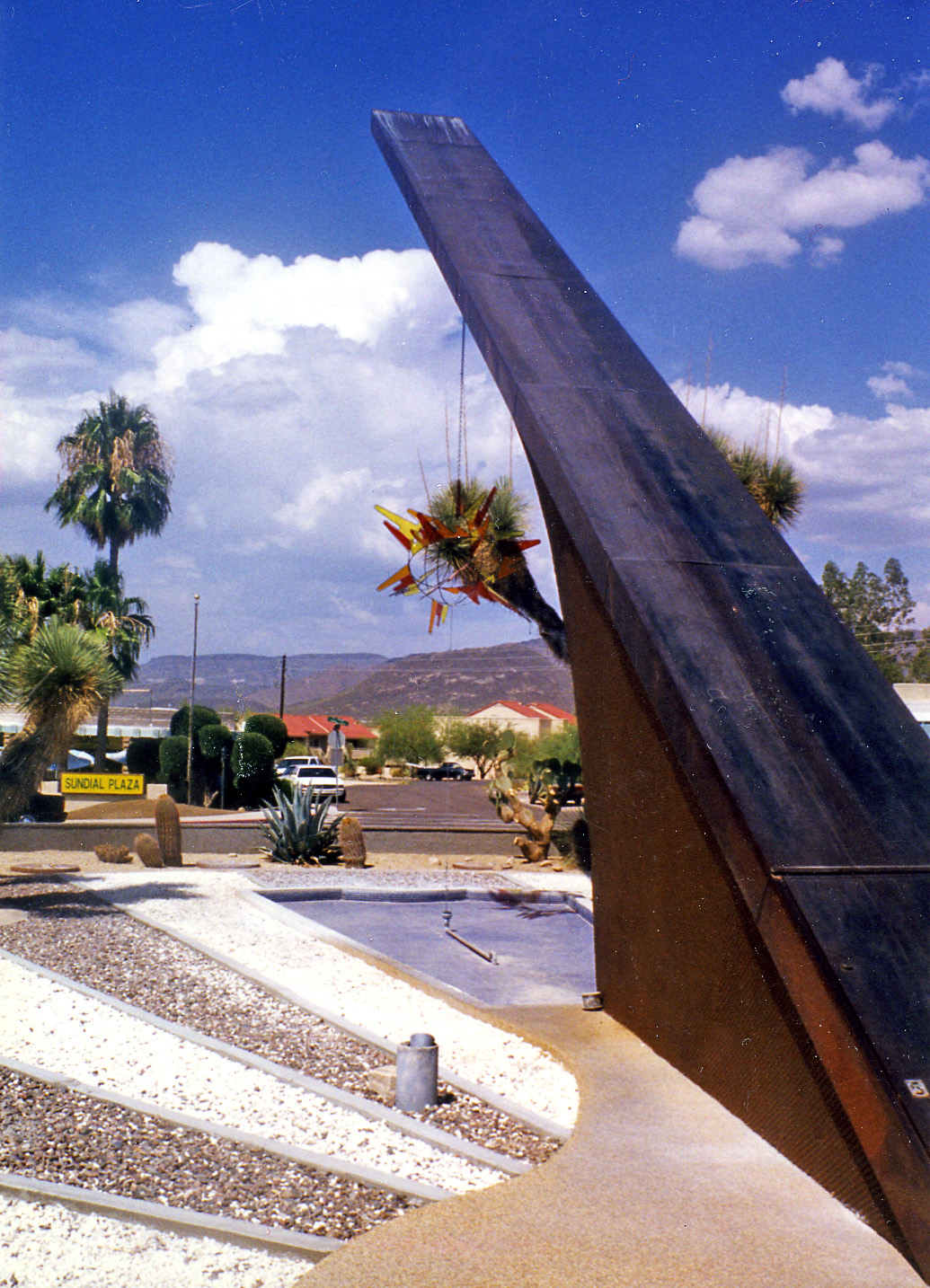 The first sundial in the NASS Registry is the dial from Carefree, Arizona. This 35 foot tall dial was designed by architect Joe Wong and solar engineer John Yellott and when built in 1959 was considered the second largest sundial in the world. You can see in the accompanying photo that hanging midway along the sundial's gnomon is a garish colored ball, a "Sunburst". [It is partially hidden by a background palm tree.] This structure was part of the original design. From the on-line Carefree City SunTimes, editor-in-chief Kathryn Miller brings us the story of its origin, demise, and now its restoration. The seven-foot wide wrought iron Sunburst has not been on the gnomon for the last 20 years. From Miller's article, "As the story was told by Carefree Vice Mayor John Crane in his March CITYSunTimes column, “The Joe Wong designed Sunburst enjoyed a short life. In 2004, when the Sunburst was determined to be beyond repair it was donated to the Cave Creek Museum where it resided outside for many years."
The first sundial in the NASS Registry is the dial from Carefree, Arizona. This 35 foot tall dial was designed by architect Joe Wong and solar engineer John Yellott and when built in 1959 was considered the second largest sundial in the world. You can see in the accompanying photo that hanging midway along the sundial's gnomon is a garish colored ball, a "Sunburst". [It is partially hidden by a background palm tree.] This structure was part of the original design. From the on-line Carefree City SunTimes, editor-in-chief Kathryn Miller brings us the story of its origin, demise, and now its restoration. The seven-foot wide wrought iron Sunburst has not been on the gnomon for the last 20 years. From Miller's article, "As the story was told by Carefree Vice Mayor John Crane in his March CITYSunTimes column, “The Joe Wong designed Sunburst enjoyed a short life. In 2004, when the Sunburst was determined to be beyond repair it was donated to the Cave Creek Museum where it resided outside for many years."
Eventually the museum returned the rusting icon to the City of Carefree, ending up in the Town garage. Miller's article now reports it's restoration that was completed in March 2021: "...[Back in] 2019, a Carefree resident, who prefers to remain anonymous, took it upon himself to return this misplaced, but not forgotten, historic and iconic art piece to its rightful place. Now, a reincarnated Sunburst, dimensionally identical to the original, but with improved design and modern materials, holds a place of honor in the Town center, once again celebrating the desert sunshine and casting its glow beneath the Sundial."
Perhaps an indicator of the times with the urge to turn night into day, this Sunburst that hangs on the gnomon is now electrified and illuminate with LED lights, blending in with the LED lighting of surrounding cactus in ithe plaza.
- Details
- Hits: 11077
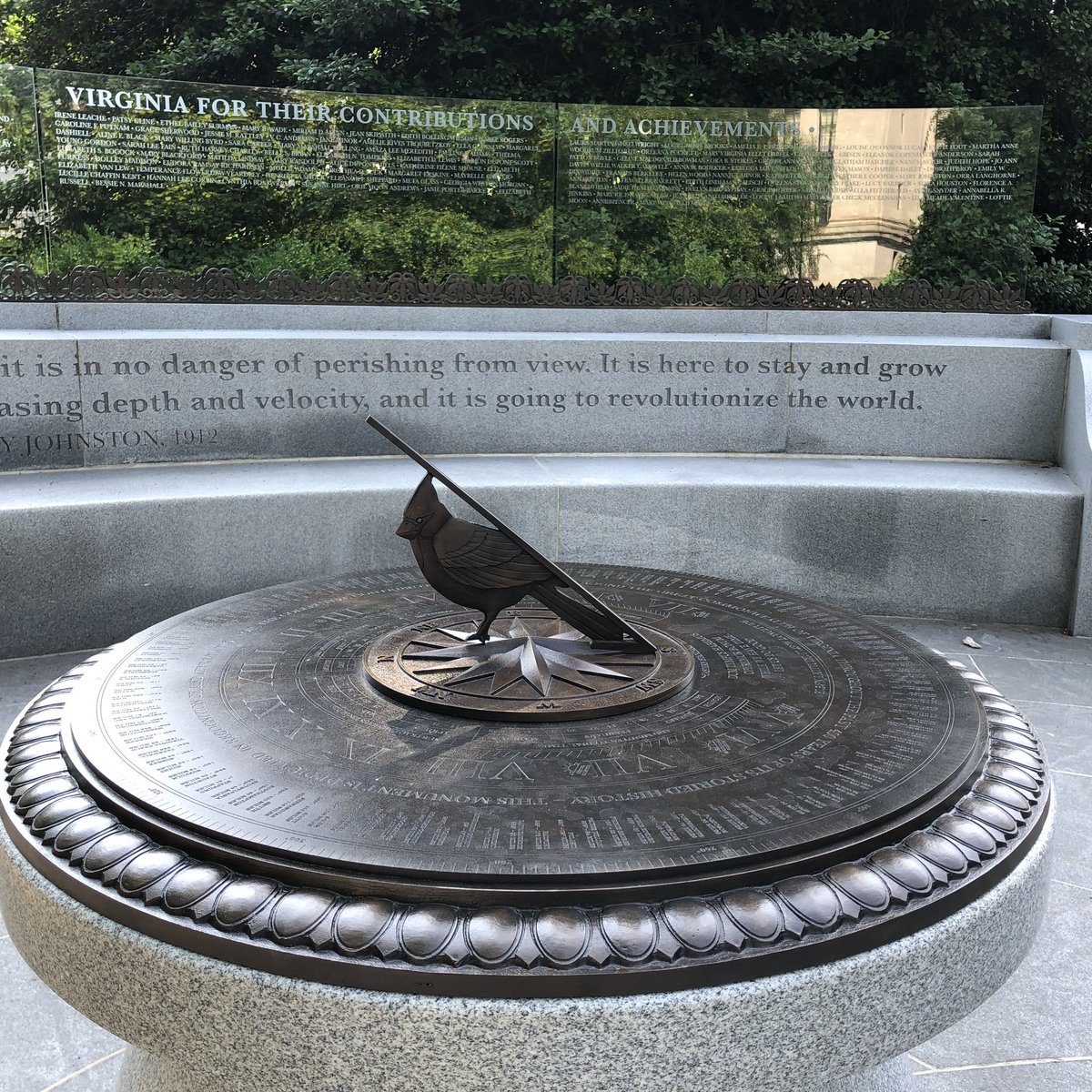 On the State Capitol grounds in Richmond Virginia the Women's Monument was unveiled on Oct 14, 2019 as part of celebrating the 100th anniversary of the 19th amendment that gave women the right to vote. The Women's Monument, commissioned by the Virginia Department of General Services, negotiated two contracts with local artists on behalf of the Virginia Women's Monument Commission who has raised more the $3.7 million for this monument. The result is a large circular plaza with 7 life sized bronze statues of influential Virginia women during the last 400years. The monument will eventually feature 5 more life-size bronze statues. The statues are backed by a glass wall with the inscribed names of 230 infuential Virginia women on the Wall of Honor.. The monument is a work in progress and intends to not only complete the last 5 statues, but add other women's names to the Wall of Honor.
On the State Capitol grounds in Richmond Virginia the Women's Monument was unveiled on Oct 14, 2019 as part of celebrating the 100th anniversary of the 19th amendment that gave women the right to vote. The Women's Monument, commissioned by the Virginia Department of General Services, negotiated two contracts with local artists on behalf of the Virginia Women's Monument Commission who has raised more the $3.7 million for this monument. The result is a large circular plaza with 7 life sized bronze statues of influential Virginia women during the last 400years. The monument will eventually feature 5 more life-size bronze statues. The statues are backed by a glass wall with the inscribed names of 230 infuential Virginia women on the Wall of Honor.. The monument is a work in progress and intends to not only complete the last 5 statues, but add other women's names to the Wall of Honor.
In the center of the plaza on a wide circular pedestal is a bronze sundial. In addition to the normal dial furniture of compass rose inscriptions, site latitude & longitude, and a chapter ring with the hours from 5am to 7pm there is additional information: points of locations in Virginia are shown around the dial in the outer chapter ring. Each location is listed by name, azimuth, and distance from the Capitol site.
With all the work to create this magnificent monument to women there is a monumental nit pick. At azimuth 354 deg and 108 miles away is "Loudon". Locals immediatedly spotted the typo for Loudoun County, which according to the official county history recorded: "In 1757, by act of the Virginia House of Burgesses, Fairfax County was divided. The western portion was named Loudoun for John Campbell, the fourth earl of Loudoun, a Scottish nobleman who served as commander-in-chief for all British armed forces in North America and titular governor of Virginia from 1756 to 1759."
In spite of the typo, the dial is an impressive work of art approximate one meter in diameter.
Photo Credit: Sara Hunt, Virginia Capitol and AA Communications
- Details
- Hits: 15663
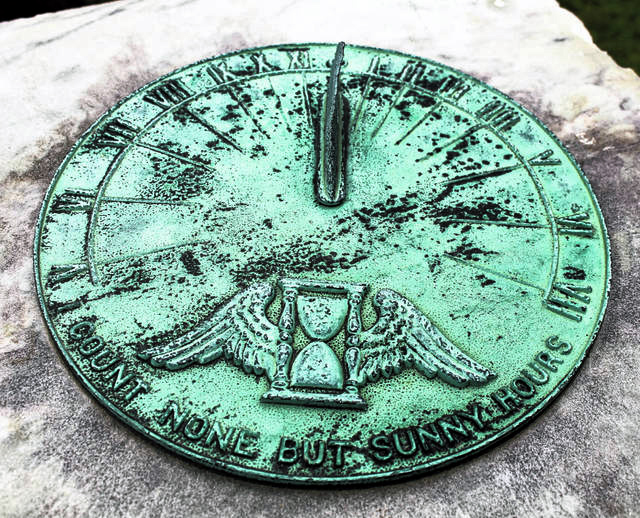 It is a small memorial sundial, only about a foot in diameter. The polished bronze face has aged with time as have the students who gave that dial to the Pomeroy Seniior High School. The sundial gifted by the graduating class of 1927 was placed on the front lawn of the school where it remained for more than 90 years. According to a short article by Sara Hawley [https://www.mydailysentinel.com/news/42283/phs-sundial-has-new-home ] "Alumni remember that area as being 'out of bounds' to them as students. They could never put their hands on the sundial - only viewing it from afar."
It is a small memorial sundial, only about a foot in diameter. The polished bronze face has aged with time as have the students who gave that dial to the Pomeroy Seniior High School. The sundial gifted by the graduating class of 1927 was placed on the front lawn of the school where it remained for more than 90 years. According to a short article by Sara Hawley [https://www.mydailysentinel.com/news/42283/phs-sundial-has-new-home ] "Alumni remember that area as being 'out of bounds' to them as students. They could never put their hands on the sundial - only viewing it from afar."
But now the school is no longer used and is being sold. The Pomeroy Alumni Association began to make plans to relocate their treasured sundial, "The sundial had previously survived several floods when it was located in front of the school. After looking at several locations, it was decided to place it on the foundation of the old bandstand in the Beech Grove Cemetery."
- Details
- Hits: 13793
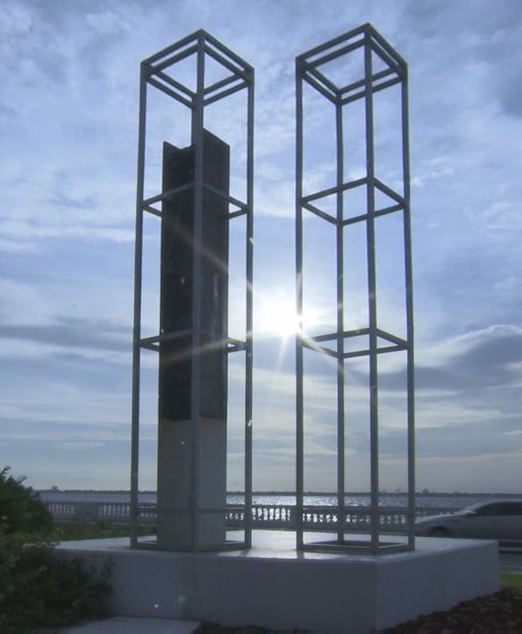 It has been 17 years since 2001 when on September 11th terrorists attacked the world trade center and the Pentagon. To memorialize this tragic event artifacts from the Word Trade Center are now in 1,100 cities, large and small, across the country that have received portions of the Trade Center wreckage from the Port Authority of New York. In Tampa along Bayshore Boulevard near Bay Boulevard is a striking memorial. Here is a World Trade Center in miniature, represented as two tower outlines, matching the orientation and scale of the site in New York City. Thin aluminum members rise from the memorial base, tracing the placement, material, and proportions of the twin towers. The memorial is one one-hundreth the scale of the actual towers and site. The memorial was dedicated on Friday, September 9th, 2018.
It has been 17 years since 2001 when on September 11th terrorists attacked the world trade center and the Pentagon. To memorialize this tragic event artifacts from the Word Trade Center are now in 1,100 cities, large and small, across the country that have received portions of the Trade Center wreckage from the Port Authority of New York. In Tampa along Bayshore Boulevard near Bay Boulevard is a striking memorial. Here is a World Trade Center in miniature, represented as two tower outlines, matching the orientation and scale of the site in New York City. Thin aluminum members rise from the memorial base, tracing the placement, material, and proportions of the twin towers. The memorial is one one-hundreth the scale of the actual towers and site. The memorial was dedicated on Friday, September 9th, 2018.
Interviewed by Fox 13 News of Tampa, John Thompson of Wilder Architect who designed the memorial explained, "So we put [the steel I-Beam from the Tower, setting] it standing straight like the column in the North Tower, symbolically." Thompson continued, "The column for the World Trade Center acts as a sundial...There's a portion of concrete base that in the morning of September 11th when the shadow of the column hits that particular piece of concrete, that's the [time of] impact of the plane on the north tower. As the morning carries on, when the column shadow falls off the concrete, that's when the building fell." American Airlines Flight 11 hit the World Trade Center at 8:46am. After burning for 102 minutes, the north tower of the World Trade Center collapsed, killing approximately 1,400 people.
According the Fox 13 News, "It's a place where joggers stop to pray and groups stop to reflect, such as the Bayshore Patriots, an organization where members stand at its corner every Friday to wave the U.S. flag at commuters. Thompson invites everyone to come out the morning of 9/11 and see the sundial."
Read more at:
http://www.fox13news.com/news/local-news/memorial-functions-as-a-sundial-tells-story-of-911#/
http://www.publicartarchive.org/node/54627
https://www.tampagov.net/news/city-tampa-dedicate-911-world-trade-center-artifact-memorial-be-installed-patriots-corner
- Details
- Hits: 13029
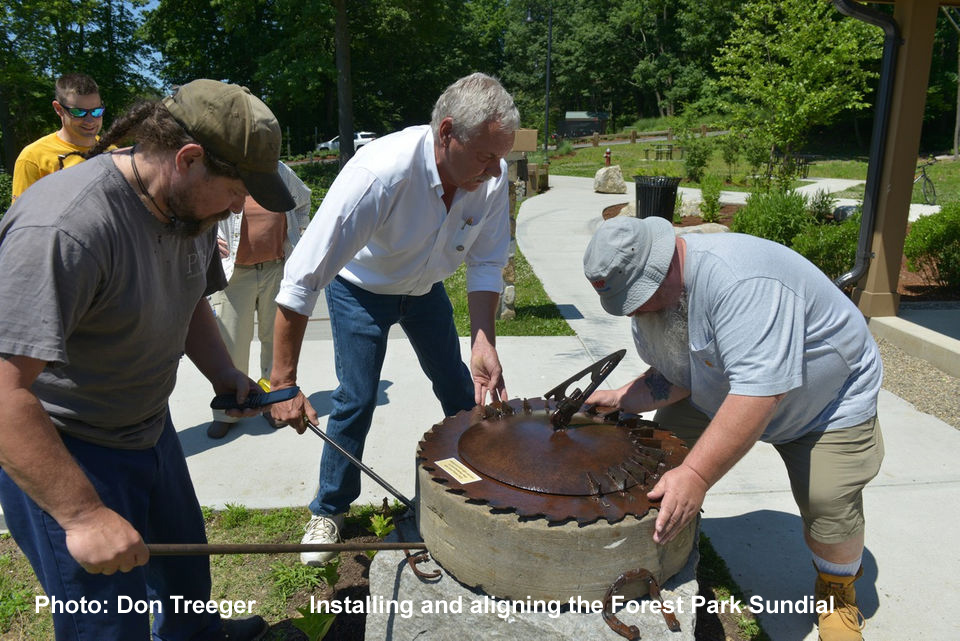 On June 6th 2018, an interest memorial sundial was donated to the Clifford A. Phaneuf Environmental Center at Forest Park, MA just off U.S. 91 and a stone's throw from the Connecticut River. According to Mass Live (https://www.masslive.com/news/index.ssf/2018/06/new_sundial_at_forest_park_env.html), "During the public ceremony, the sculpted sundial was donated by the family of retired Hampden County Housing Court Judge Edward C. Peck Jr. and dedicated in memory of Peck's late wife, Ruth Mahoney Peck." The Peck family commissioned sculptor James Kitchen who created a run-patina steel sundial with the base of an old mill circular saw blade and setting a pipe wrench and ice skate blade welded together as gnomon. According to Burt Freedman, a retired teacher of the Environmental Center for Our Schools at Forest Park, the dial provides references to the industrial and agricultural history of Springfield and Forest Park.
On June 6th 2018, an interest memorial sundial was donated to the Clifford A. Phaneuf Environmental Center at Forest Park, MA just off U.S. 91 and a stone's throw from the Connecticut River. According to Mass Live (https://www.masslive.com/news/index.ssf/2018/06/new_sundial_at_forest_park_env.html), "During the public ceremony, the sculpted sundial was donated by the family of retired Hampden County Housing Court Judge Edward C. Peck Jr. and dedicated in memory of Peck's late wife, Ruth Mahoney Peck." The Peck family commissioned sculptor James Kitchen who created a run-patina steel sundial with the base of an old mill circular saw blade and setting a pipe wrench and ice skate blade welded together as gnomon. According to Burt Freedman, a retired teacher of the Environmental Center for Our Schools at Forest Park, the dial provides references to the industrial and agricultural history of Springfield and Forest Park.
The Hour Lines are short vanes of steel raised about 1" above the circular saw blade. A slight dome extends from the hour line circle to the center where the sundial gnomon sets. Although the 6am-6pm line meets the base of the gnomon, the fact that the gnomon is raised 2 or more inches above the saw blade, sets the virtual foot of the gnomon far back of the 6-6 line. Thus, although the sundial is esthetically beautiful and represents history of the area, perhaps it tells time with considerably more error than expected from the Equation of Time. [No longitude correction is provided, resulting in nearly 10 minutes of constant error.]
- Details
- Hits: 13320
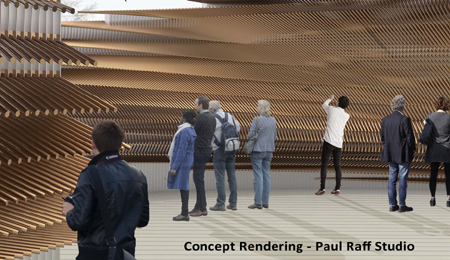 A memorial, the Arc of Memory, will be completed in 2018 on the west side of the Garden of Provinces and Territories in Ottawa. The design by Paul Raff's Sutdio is a "living calendar". Raff described the memorial as a way to “honour the 8 million Canadians that can trace their origins to countries that suffered oppressive regimes of communism by creating an instrument of memory.” In essence Raff is designing a huge digital sundial (or as he calls it, a "three dimensional calendar"). According to Erin Dommely of Azure Magazine, the memorial is constructed of two curving walls 4 x 21 meters containing 4,000 short bronze rods arranged in 12 dense rows across a series of 365 stainless steel fins. Erin describes the Arc of Memory's principle of having each rod uniquely angled towards the sun, whereby each hour of the day is illuminated each day of the year.
A memorial, the Arc of Memory, will be completed in 2018 on the west side of the Garden of Provinces and Territories in Ottawa. The design by Paul Raff's Sutdio is a "living calendar". Raff described the memorial as a way to “honour the 8 million Canadians that can trace their origins to countries that suffered oppressive regimes of communism by creating an instrument of memory.” In essence Raff is designing a huge digital sundial (or as he calls it, a "three dimensional calendar"). According to Erin Dommely of Azure Magazine, the memorial is constructed of two curving walls 4 x 21 meters containing 4,000 short bronze rods arranged in 12 dense rows across a series of 365 stainless steel fins. Erin describes the Arc of Memory's principle of having each rod uniquely angled towards the sun, whereby each hour of the day is illuminated each day of the year.
The two walls are split at the winter solstice and "On the darkest day of the year the design would invite visitors to step through in a metaphorical journey from darkness and oppression to lightness and liberty.”
Read more at: http://www.azuremagazine.com/article/memorial-victims-communism-design-revealed-ottawa/
- Details
- Hits: 12969
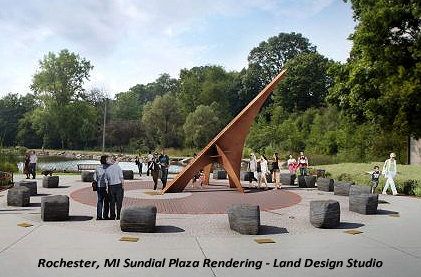 Rochester, Michigan was settled in 1817 and is now celebrating its Golden Centennial with a sundial. The city is on the northern outskirts of Detroit, with more than thirteen thousand citizens. According to Natalie Broda, Rochester City Council approved $190,000 for the sundial, but the cost of the project is expected to exceed that due to the unstable, uncompacted ground that the heavy monument will sit on." The dial will be unveilled as part of the bicentennial homecoming envent scheduled for August 12, 2017.
Rochester, Michigan was settled in 1817 and is now celebrating its Golden Centennial with a sundial. The city is on the northern outskirts of Detroit, with more than thirteen thousand citizens. According to Natalie Broda, Rochester City Council approved $190,000 for the sundial, but the cost of the project is expected to exceed that due to the unstable, uncompacted ground that the heavy monument will sit on." The dial will be unveilled as part of the bicentennial homecoming envent scheduled for August 12, 2017.
Broda continues,""The sundial is the brainchild of Rochester’s city beautiful commission, which had been mulling the project over for several years according to Nik Banda, deputy city manager. The project was chosen after a request for proposals was sent out from city council." The sundial design was done by Russell Thayer, a sculpture artist from Franklin, Michigan.
The 20-foot tall gnomon of triangular cross section will be constructed with weathering steel, otherwise known as corten steel. Broda notes that this material was chosen to pay homage to the steel used throughout the old knitting mills of historic Rochester.
aewinc.com describes the surrounding hour marks as part of "Twenty stones [each weighing over 1000 pounds] within and surrounding the plaza have been carefully sited to celebrate twenty decades of history. The decorative stones are indigenous to Michigan and have colors that complement the gnomon; they will serve as both seating and focal elements, as well as [hourly] time markers for the sundial. Historic plaques will be placed on the stones highlighting historic events which occurred during each of the twenty decades." To increase the historical retrospective, reclaimed 100-year old bricks from historic Main Street buildings will be used to complete the circular plaza around the sundial monument.
- Details
- Hits: 23911
|
Today it is snowing in Washington DC and it brings to mind a winter some 43 years ago when the Washington Monument was turned into a sundial. Over the years many have proposed turning this spiring monument into a sundial. For example at the first North American Sundial Society (NASS) Conference in 1995 Robert Terwilliger drew a map of the shadow's excursion from Independence Avenue to E Street NW, repeated here at left. In June 2011 in the NASS Quarterly Journal The Compendium Robert Kellogg suggested that "...the precise shadow lines drawn in [Terwilliger's map] are precise geometrical constructs. The problem is the sun is not a point source, but a disk about 1/2 degree in diameter. The result is the sun casts a penumbral (partial) shadow when it is partially obscured, resulting in a range of light to dark sunlight that blurs the edges of shadow, making a gradient from light to dark.
To get a feeling for the impact of the penumbral shadow from the Washington Monument, we start with a brief summary of the Monument: A competition was held in 1836 and won by architect Robert Mills who designed a tall obelisk. Excavation began in early 1848 and the cornerstone was laid as part of the 4th of July ceremony by the Freemasons. Lack of funds created a hiatus in construction in 1858, and finally the capstone to create a pyramidal point to the obelisk was laid December 6th, 1884. The obelisk as we see it today is 169.29 meters tall, 16.8 meters wide at the base and 10.5 meters wide at the start of the capstone pyramid. The pyramid itself is 17m tall, with a small aluminum capstone at the tip and by the time the sun is sufficiently blocked by the top of the oblesk for us to see the shadow, the sun is well below the tip.
- Details
- Hits: 11578
 Mathematics professor Jerry Duncan Taylor passed away in 2013, but his 46 years of teaching lives on at Campbell University in Buies Creek North Carolina just south of Raleigh. A commemorative sundial in front of Taylor-Bott Rogers Fine Arts Building was dedicated on Wednesday, March 21, 2016.
Mathematics professor Jerry Duncan Taylor passed away in 2013, but his 46 years of teaching lives on at Campbell University in Buies Creek North Carolina just south of Raleigh. A commemorative sundial in front of Taylor-Bott Rogers Fine Arts Building was dedicated on Wednesday, March 21, 2016.
The highly polished dial, approximately 12 inches square, with an inclined bar gnomon sits on a plinth embedded in a low brick wall for all to see. There are time marks for every 10 minutes, with standard time given as Roman numerals and daylight savings time one hour later given in larger Arabic numbers.
Professor and mathematics department chair Meredith Williams recalled the start of his teaching career at Campbell: "I'm not sure I would have made it through my first semester without Dr. Taylor. I had an extremely challenging group of students in a class who were determined to see how hard they could push the new professor. Dr. Taylor always had an encouraging word for me before I went to class."
Rachel Davis quoted Provost Mark Hammond from the sundial dedication (http://www.campbell.edu/news/item/sundial-dedicated-to-late-math-professor) "We wanted something physical that we could see, celebrate, and reflect on him and the good man that he is and the way he has touched many of the people here... [his] very inspired spouse, Louise Taylor, thought that perhaps we could memorialize Jerry through a sundial. It gives us the time to pause and reflect and think about Jerry."
Page 1 of 2
